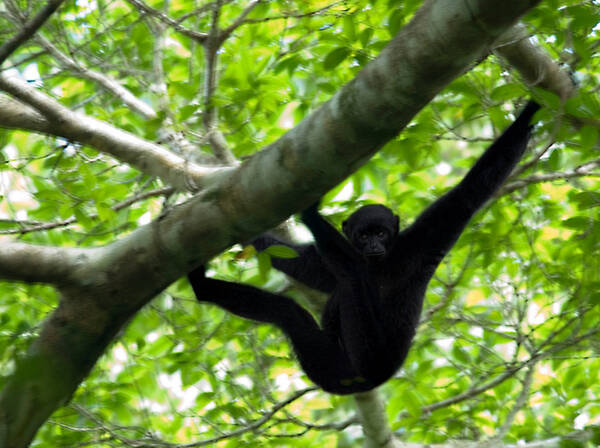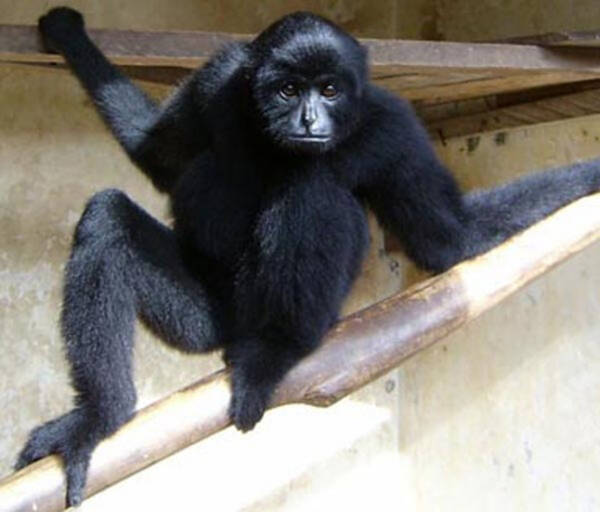Hylobates klossii
IUCN
LCBasic Information
Scientific classification
- name:Hylobates klossii
- Scientific Name:Hylobates klossii,Kloss’s Gibbon,Cross's gibbon, Mentawai gibbon, Japanese gibbon
- Outline:Primates
- Family:G.family genus
Vital signs
- length:44-63.5cm
- Weight:5.6-5.9kg
- lifetime:25-44years
Feature
It has longer canine teeth, calluses on the buttocks, no tail or cheek pouches, and a larger vocal sac in the throat.
Distribution and Habitat
Distributed in Indonesia and western Sumatra, Siberut Island, and North and South Pagai Islands in the Mentawai Islands.
It mainly lives in tropical rainforests in South Asia and Southeast Asia, active in the upper canopy of semi-deciduous monsoon forests and tropical evergreen forests.
Appearance
Females are slightly larger than males, with males weighing about 5.6 kg and males weighing about 5.9 kg. Head-body length 440-635 mm. The fur is black, dense and shiny. There are hip pads. Like other gibbons, it has extremely long arms and fingers. This provides adaptive assistance when swinging between trees. The legs are short, the palms are longer than the soles of the feet, and the finger joints are long; the body is slender, the shoulders are broad and the hips are narrow; there are long canine teeth. There are calluses on the hips, no tail and cheek pouches. There is a large sound bag in the throat, and it is good at singing.
Details
Kloss’s Gibbon (scientific name: Hylobates klossii) is also known as Kloss’s Gibbon in English. It has no subspecies.

Clark's gibbons usually live in small groups of families, including one adult male and one adult female, and the rest are semi-adult and young gibbons, with an adult male serving as the leader. Gibbons have a relatively long maturity period, and family relationships are not only stable, but also harmonious and friendly. Family members are generally very harmonious, caring for each other and defending each other.
The habits of the Clark's gibbon are similar to those of other gibbons. They live a family life with males and females as partners. They are territorial. The territory of each group is about 20 to 35 hectares, but they only forage within 10 hectares in a day. During the day, they usually climb branches with their arms at least 10 meters high in the forest, swing and jump, using both their front and back limbs at high speed. The moment they leave the space between two trees, they seem to be flying in the air. Due to the high-altitude characteristics of this movement, they often change the direction of their chest and arms. Long-term evolutionary adaptation has made the sides of their shoulders flat, unlike monkeys, which are relatively wide. Their elbows are longer and can rotate 360 degrees in all directions. They can move forward and backward quickly, and their feet only play the role of assisting pedaling. They can move on two feet for a short distance on the ground. The average distance they move every day is 1514 meters. They have keen hearing and smell, are timid, and are afraid of cold. They are arboreal species and sleep in trees at night. Active up to 10 hours a day.
Tactile communication is important among family members of the Clark's gibbon, and involves grooming, mating, play, and sometimes aggression. In addition to vocal and tactile forms of communication, these animals also use facial expressions, gestures, and body postures to communicate with their own species.

The Clark's gibbons are well known for their loud calls, which they use to communicate. Females tend to have a slow rise and fall, interrupted by trills, which is the most distinctive call. The male's call is sandwiched between the female's calls, starting with a moan and gradually rising. A 10-minute solo song is performed 2 hours before dawn. Typically, duets form during the breeding season, generally 2-3 hours after daybreak, with females lasting about 15 minutes. Occasionally, young Clarke's gibbons will join their parents in a duet. It is speculated that the duet is to intimidate neighbors, defend their territory or as a means of maintaining social organization. Studies have shown that males and females can be identified by their calls, and each animal has its own unique voice. Calling is the main way for group members to communicate. Every morning, males and females sing in chorus, or in a rhythmic, or sad and low, or make intervals similar to blowing bubbles. The males also add a tail sound at the end of the call.
Clarke's gibbons consume a lot of fruit. Like other gibbons, these animals mainly eat fruits with high sugar content, such as figs, which account for 75% of the total diet. They also eat a variety of other foods, including leaves, flowers, insects, bird eggs, and small vertebrates, which account for 25%. In the wild, it has been observed that Clarke's gibbons spend a lot of time looking for arthropods to feed their young.
A pair of Clarke's gibbons can give birth to 5-6 babies in their lifetime, with an interval of 2-3 years between births. The male's testicular scrotum is short and covered with sparse hair. The female's labia majora is prominent, making it difficult to identify and distinguish the sex from appearance in the wild. There is no strict breeding season. The gestation period of females is about 7-8 months. After mating and conception, they still move with the group. After 3-4 months, the abdomen will bulge slightly. As the fetus grows, the abdomen gradually increases. Daily actions become more cautious, but they still stay with the group until giving birth. Delivery usually occurs in autumn and early winter, and only one baby is born per litter. The newborn baby is light yellow in color and weighs 110-170 grams. After 4-5 months of age, it gradually turns black or brown-black. The weaning period is up to 24 months. They live in the family group until they are 6 years old. During this period, subadults will participate in taking care of their younger brothers and sisters. When they are close to sexual maturity, they will slowly leave the group and live independently. Usually, parents urge young Clarke's gibbons to enter new areas and threaten those teenagers who occupy new areas to enter the original family territory. They are sexually mature at the age of 6-7 and look for mates. The lifespan is about 25 years. It can reach 44 years in captivity.
Due to large-scale logging, the habitat of Clarke's gibbons is rapidly decreasing. The loss of habitat for gibbon species is the main threat due to logging and agricultural needs.
Listed in the 2008 Red List of Endangered Species of the World Conservation Union (IUCN) ver 3.1-Endangered (EN).
Protect wild animals and stop eating game.
Maintaining ecological balance is everyone's responsibility!








